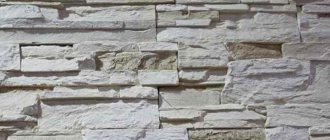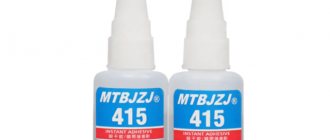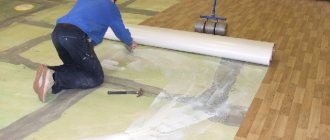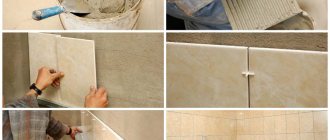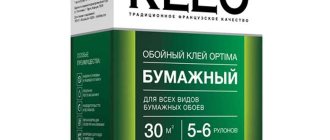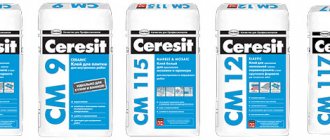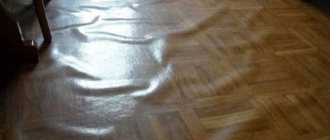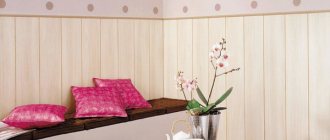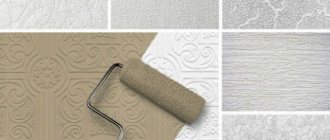Painting fiberglass web finds its application in reinforcing surfaces before finishing work. This material is not a finishing type coating, it is, so to speak, the basis for further finishing of walls and ceilings. The cobweb can be called an effective assistant in the fight against such serious problems as cracks on the surface of ceilings and walls.
Quite often, problems with cracks arise in new houses that were built relatively recently, because over time the house shrinks; painting fiberglass web, the use of which is appropriate in this case, is the best assistant in this situation.
It should also be noted that this type of finishing coating for walls today is gaining popularity in the market of finishing materials, and with quite serious momentum. The type of “preparatory wallpaper” in question has similarities and differences with glass wallpaper. We will also compare the manufacturing process of paper and fiberglass.
Technical characteristics and scope of material
Painting fiberglass canvas consists of fiberglass threads, like glass wallpaper, but the difference is that the web is not made on machines. The manufacturing process of the “wallpaper” in question is as follows: fiberglass comes under a press, as in the process of manufacturing sheets of paper. The result of such pressing is smooth, thin sheets, the surface of which is very smooth. The density of compressed fiberglass is 25-50 g/m2.
Although the process of making fiberglass webs and paper are to some extent similar, the difference between them is colossal - unlike paper sheets, they do not accumulate statistical electricity on their surface, and they are also not afraid of water, mechanical damage, or chemical reagents. Dust is also not attracted to them and, among other things, they do not burn. It is difficult for some to imagine what such a finishing material looks like, therefore, you can watch a video showing how to use fiberglass for painting in this article.
Similar characteristics of cobwebs and paper include their composition, namely, the ingredients included in its composition are exclusively natural, as in paper, they are also a non-allergenic material, and they allow air to pass through perfectly. The difference between fiberglass and glass wallpaper is the absence of a wicker pattern and relief on the surface of the former. But this also has its advantages, if there are no prominent elements on the surface, it means they can be painted an unlimited number of times, no relief - no problem.
How to properly glue painting fiberglass
In order to stick the material on the walls or ceiling, you do not need to have any special skills or knowledge. You just have to find out how it's done and get to work. If you don’t want to pay a lot of money to craftsmen for a fairly simple finishing process, then just follow the recommendations that will help you do everything correctly and quickly.
- To begin with, glue is applied to the surface of the ceiling or walls; you don’t need to apply a lot; it will be enough to apply glue one strip wide. The substance is absorbed quickly enough, so there is no need to remove it from under the finishing material.
- There are no standards for the width of the strips, you can cut them as you wish, the main thing is that it is convenient to work with them. With the finishing of the walls everything will be simpler, so you can cut the strip to its full length, but for the ceiling a strip of one and a half to two meters will be enough. Before gluing, check where the front and back sides are. They look very similar, but there is a difference in them, so you will find all the necessary information about this on the label.
- Painting fiberglass canvas: the use of which is suitable for all surfaces in the room, and even for plasterboard structures, after fitting to the wall, it is smoothed out carefully with your hands. You need to make sure that the corner of the room coincides with the edge of the web. After that, it is necessary to run a spatula over the surface so that no air remains under the coating.
- When the sheet is firmly attached to the wall, you can start cutting off all the excess that sticks out or hangs. Then apply glue to the surface again. To understand that the sheet is well soaked, it should become dark from moisture.
- We glue the next sheet, the same size as the previous one, to the wall, making sure to overlap. If the material is glued to the ceiling, then it is better to glue it along the room.
How to choose the right one
Wallpaper is selected based on density and the thickness of the rolls themselves. It should be remembered that manufacturers can use more impregnation for this. It compacts the roll itself, but does not provide any texture, and the design turns out inexpressive. If the manufacturer uses loose threads for textured patterns, then after squeezing out the air with a spatula, the pattern becomes flat.
To avoid getting into an unpleasant situation, you can choose glass wallpaper in the following ways.
- Take a small piece of canvas and stick it on the wall. Then you need to paint the surface and treat it with a spatula. If the material on the wall is not flattened, it means the product is of high quality and you can work with it.
- If you can’t experiment, choose well-known brands. Companies value their reputation, which means the gluing result should be strong, textured, and durable.
Manufacturers
Among manufacturers, it is better to trust world-famous names. This applies to the Swedish company Johns Manville and its Oscar, Welton, Tassoglas series. Glass wallpaper from the Vitrulan series from the German manufacturer Vitrulan Textilglas GmbH is in demand. Such wallpaper can withstand serious mechanical loads, even if the surface itself is wet.
The quality of the roll can be checked by touch, but after gluing it to the wall it may not be as dense. This is due not only to loose threads, which makes the result flat, but also to the addition of starch to the composition. The latter option gets wet upon contact with liquid glue, and the wallpaper itself becomes loose.
The density of good wallpaper should be at least 145 g/m2. m. If the indicator is not in the characteristics, take rolls with a large weight. According to the marking, choose first-grade glass wallpaper. There may be black stripes on the roll. This indicates a defect, for example, places with crooked or fallen threads. Then another 50 cm of canvas is added to the standard length.
Glue consumption per 1m2
The question of glue consumption when finishing walls or ceilings with fiberglass paints arises quite often, because such a process will require a lot of it.
The problem is that there are no standards in this regard. It is impossible to accurately calculate the amount of glue that will be used per square meter of surface, because it will depend on who will apply this glue to the surface.
If there is little glue, you will see it yourself; if there is too much glue, it will also be difficult not to notice. In order to sufficiently saturate the surface with glue, you must monitor the color of the fiberglass web; as soon as it darkens from moisture, there is a sufficient amount of glue on its surface.
- After we have glued the second sheet with an overlap, we saturate it with a layer of glue and, without fail, press it well against the wall. In order for the seams between the sheets to be invisible, you need to cut a strip through both glued layers, even if your cut turns out to be uneven, there is nothing wrong with that, we strive to ensure that the surface is smooth, and these unevenness of the strip you cut will not be visible on wall or ceiling.
- After 24 hours, the glue on the surface will dry completely, and you can proceed to the next stage of finishing.
Painting fiberglass web application: how to paint
If you decide to paint the canvas, then we recommend using water-based paint for such a surface. Such paint will retain the properties of the finishing material itself and, moreover, more than one layer of paint can be laid on it in an even layer.
For painting you will need the following tools:
- a tray where the paint will be poured;
- a roller, preferably with a thread-type pile (you can use a paint brush, but then the painting process will take a long time).
It is necessary to paint the fiberglass spider web twice, that is, apply two layers of paint. It is worth noting that the time between applying layers should be at least 12 hours. To roll a seam, you need to use a “wing”; if you do it with a roller, the result will not be optimal. In principle, these are all the features of painting such a finishing material.
Do I need to putty on fiberglass paint before painting?
A positive quality of the web is that after gluing it to the wall, you can immediately begin painting the surface of the walls or ceiling. In this case, the word immediately means. After the surface has completely dried, simply without preliminary or preparatory work.
It is necessary to putty only if you want to have a completely flat surface of the wall or ceiling or if you want to hide the texture of the finishing material, in this case - cobwebs.
The best option for preparatory work before gluing would be to prime the fiberglass with glue, thereby reducing paint consumption. This is correct and profitable, because glue is much cheaper than paint.
Is it possible to glue wallpaper onto fiberglass webs?
To begin with, I would like to say that painting fiberglass is a material that serves to reinforce surfaces, and it is glued to secure plaster, putty, and also to avoid the appearance of cracks on the walls. This material is excellent for painting.
As for wallpaper, in the case of fiberglass, you can glue it, but before that you will have to treat the surface of the wall or ceiling, and only then start gluing the wallpaper onto the surface.
Since painting fiberglass web, the use of which is a protection against cracks, is not a finishing coating, it can be either painted or glued on top of wallpaper, but after first treating the surface.
If the gluing process seems difficult to you and somewhat incomprehensible, then we recommend that you watch the video on our website, which describes in detail and shows how to properly glue fiberglass webs to various surfaces.
Source: masterok-remonta.ru
(part A+B / 10 kg)
Source: m-delivery.ru
Reviews
Professionals urge you to buy Oscar products, since the quality of the glue is sufficient to carry out repairs yourself. Users of Oscar glue are also satisfied with its properties and ease of use. This glue is ideal for quality repairs.
To take advantage of the excellent quality of the Oscar adhesive composition, but at the same time save their budget, buyers are advised to purchase dry glue, because diluting the mixture with water will not be difficult, but will also save a couple of hundred rubles.
Customers also appreciate the versatility of this product, since it is suitable for different types of wallpaper.
To learn how to properly dilute Oscar glue, watch the following video.
Fiberglass canvas (gossamer fiberglass canvas) is an environmentally friendly, reliable material for strengthening walls, ceilings, and reinforcement in corners and in areas prone to destruction. If the gluing technology is strictly followed, the fiberglass canvas will last for many years. The main condition for long-term operation is the correct choice of glue.
Advantages and disadvantages of fiberglass web
Like any material, x-glass “gossamer” has its own characteristics, positive and negative qualities.
| pros | Minuses |
| There is no need to call a professional to do the job; you can glue it yourself at home. | Work in closed clothing, a mask, and glasses to prevent glass particles from getting on your skin. |
| Resistant to chemicals. | Peeling may cause problems as the material is durable. |
| Not afraid of water. Vapor permeability. Used for kitchen, bathroom, balcony. | Not plastic. When gluing, the surface must be flat. Otherwise, the next coating will crack. |
| You can touch it with your hands and clothes every day, you won’t do any harm | High cost price. |
| Eco-friendly coating. | High paint costs. |
| Durable material. Serves in operation for up to 35 years. | The composition contains phenols, formaldehydes. |
| Decor. A wide choice of interior design: gluing non-woven wallpaper, painting walls, decorating. | Poor quality material can break and crack. |
| They are not afraid of fire. | |
| Pasted with overlap |
Technical characteristics and scope of material
If you use painting fiberglass, you will get an environmentally friendly room. Fiberglass canvas for painting is produced by many manufacturers, which one should you choose? Wellton (W30,W40,W50), Semtex, Holtex, glass, Weltex, Polinet are the best on the sales market.
The price for one roll is 500 - 800 rubles. The volume is 25 m2 or 50 m2. Universal width 1 m.
Painting fiberglass web is used in repair work of walls and ceilings. Fiberglass, Velton, properly glued to plastered or plasterboard walls. Replaces finishing putty. It is glued with special glue, primed, puttied, dried, and then painted with a roller.
If you avoid putty, you need to prime it with a liquid solution and paint it. In this case you need a lot of paint. For what? Because you need to paint 3-4 times. How to paint fiberglass spider web is presented in the video:
How to properly glue painting fiberglass with photos and videos
Is it possible to glue wallpaper onto fiberglass fiberglass? This phrase is often heard by consultants at construction stores. There is a special technology for working with the material. Before gluing, preparatory work is carried out. If the walls have minor flaws, there is no need to repair anything. If large cracks are naive, treat them with putty. After drying, apply plaster. The result is a smooth surface treated with a primer solution.
Now let's start gluing. Apply glue liberally to a dry wall or ceiling. It is recommended to apply approximately the size of one sheet. Thanks to good fit, there will be no excess glue under the fiberglass. For ease of use, cut the sheets in advance. It is important not to confuse the front side. Gradually applying the side of the canvas to the wall, you need to smooth it with your hands or a construction triangle. Remove air and excess glue after gluing in the same way. Next, remove the excess length and soak the top of the sheet with glue. After some time, smooth the finished surface with a spatula again. The other sheet is glued overlapping. Impregnate the surface with adhesive and overlap the finished glued sheet. For an even and invisible seam, you need to cut a strip through both layers. Afterwards, coat the joint well with glue. The result will be a smooth seam without any sticky tape. In the corners there is Oscar fiberglass, cut. It will take a day to dry. Next comes finishing. If the wall is to be painted, we putty the surface 2 times. For wallpaper gluing – 1 time.
Fiberglass web
Preparation
- First you need to thoroughly clean the base. Dust and dirt are removed from the walls and ceiling, and large potholes and depressions are repaired. If the fiberglass will stick to the plaster, then the surface must be wiped several times with a wet woolen rag. Surfaces that will not be used for gluing (windows, doors, furniture, floors) are covered with oilcloth or polyethylene.
- The dry powder is diluted in the prepared container according to the instructions indicated on its packaging. You need to mix the components immediately before work, since if prepared ahead of time, the mixture may dry out and be difficult to work with. The water for diluting the mixture should be at room temperature. Stir the mixture with a stick or mixer. Afterwards, the finished product should sit for 5-10 minutes.
- Now you can start marking the dimensions of the fiberglass sheets (with a marker or pencil).
- The roll of fiberglass is unrolled and laid on the floor, the wrong side should be at the top. It is cut into strips of the required sizes in accordance with the markings made.
Glue consumption per 1m2
You will need special glue for fiberglass web, such as for glass wallpaper. It’s not often that manufacturers sell it as a set of fiberglass. For quality work, you must follow the instructions correctly to avoid a liquid consistency. You need to buy glue with a reserve, because it will require a lot of consumption. Oskar-profi fiberglass painting canvas does not like through air when drying. It is recommended to close doors and windows during work. On average, 200 ml is used per 1 liter of water. glue.
We sell ready-made glue based on PVA and starch. On average, a 15 kg bucket of glue is used for 25 m2. Accordingly, 0.4 kg of glue will be used per 1 m2. You can determine exactly how much glue you need using the description on the package.
Composition requirements
A high-quality mixture should contain such components.
- Plasticizers. Due to them, the adhesive surface will be elastic even after complete drying. It will not crack or burst.
- Polyvinyl acetate (PVA). Universal adhesive base without toxic components, suitable for working with most substrates.
- Fungicides. They prevent the growth of bacteria that destroy materials in the base, and prevent the development of mold, rot, and fungus.
- Modified starch.
- Bactericidal additives.
It is better to use the products that come with fiberglass, but if you buy the product separately, look at the scope of its application and the components included in the composition.
Tips for choosing glue:
- Liquid glue retains its qualities for 10 days after opening.
- To prepare the dry mixture, it will take 15 minutes for swelling.
- High-quality glue does not stain, does not form stains, and is odorless.
- Colorless when dry.
- Contains antifungal components.
- The composition contains chalk for flexible application.
- Dries completely in 2 days.
The following trademarks have such characteristics: Kleo, Metylan, Quelyd, Pufas. Sold in liquid and dry form. Packaging of dry 250 and 500 grams. Liquid glue is produced in 5 kg, 10 kg, 15 kg.
Tip: It is not recommended to save and add more water, otherwise the material will not be strong and will begin to peel off.
Source: otdelkasam.ru
Advantages of glue
“Oscar” is a water-dispersible acrylic adhesive composition, which was developed in Russia according to European standards specifically for decorating surfaces with glass wallpaper and covering walls with fiberglass for further painting.
The main advantage of glue is ease of use. The liquid composition is applied not to the canvas, but to the surface to be decorated. “Oscar” is elastic, so even the glued canvas can be easily adjusted. Other advantages of glue:
- Invisible after drying. The dried wallpaper adhesive becomes transparent.
- Quick cooking. Oscar is diluted with cold water, swells in 10 minutes and does not form lumps.
- Versatility. The diluted mixture is used to glue fiberglass canvas, fiberglass, non-woven and paper wallpaper. Oscar is applied to concrete, brickwork, and other substrates.
- The antiseptic in the composition prevents the appearance of fungus and mold, even if the room is very humid.
- Economical. To prepare 3 liters of the mixture you will need only 100 g of dry powder. The consumption of finished glue does not exceed 350 g per 1 square meter. m of canvas.
- Eco-friendly and safe, does not pose a threat to the health of people and pets.
On a note! Oscar glue can be stored well in its finished form in a tightly closed container for 2 months.
Compound
As you know, the main component of any glue is starch. Now modified starch is being produced, which has greater properties than regular starch. It has excellent adhesive resistance. To regulate the canvas during gluing, latex is added to the composition. In addition to starch and latex, antiseptics and fungicides are added to the glue to prevent fungus and mold. The concentration of these substances is low to cause harm to humans, but sufficient for high-quality pasting. Methylcellulose retains water. The composition includes enzymes for quick drying, and also imparts moisture and frost resistance to the adhesive composition.
Characteristics
Dry mixture "Oscar" is sold in:
- 200 gram and 400 gram cardboard packages;
- kg and 10 kg bags.
The finished glue is packaged in plastic containers of 5 or 10 kilograms.
Ready composition
Oscar liquid adhesive mixture for interior work can be stored for up to 3 years in unopened packaging. The composition is frost-resistant; you can keep the container with glue for a month at temperatures down to -40 degrees. However, it becomes unusable after the 5th defrost.
Dry adhesive mixture
The one-component adhesive composition "Oscar" for interior work is also frost-resistant, but the shelf life is less than that of the liquid mixture and is 2 months. The product is odorless.
Price
Oscar is a fairly popular brand, so it won’t be difficult to find it in any store. For a box of 200 grams you will have to pay from 150 rubles. A box of 400 grams can be purchased for 240–300 rubles. A bucket with a volume of 800 grams costs about 500–700 rubles. 10 kg of finished glue will cost 950–1200 rubles.
Consumption
Glue is economical. The consumption of the finished composition differs depending on what it is used for. 10 kg of dry mixture is enough to stick:
- 50 sq. m of glass wallpaper;
- 66 sq. m of non-woven fabrics.
The same number of kilograms will go into a primer of 132 square meters. m of prepared surface.
Important! If a person uses a ready-to-use Oscar adhesive mixture, then 5 kg of wallpaper glue is enough to glue 20-25 square meters. m of canvas.
Release form and types
Dry Oscar, 800 g (bucket)
Ready Oscar, 10 kg (bucket)
Dry Oscar, 400 g (bucket)
Dry Oscar, 400 g (pack)
Ready Oscar, 5 kg (bucket)
Dry Oscar, 200 g (pack)
The dry mixture is diluted with water and becomes ready within 5 minutes, without lumps forming. To mix large volumes, a mixer or drill with a special attachment is usually used. A pack of 400 grams is designed for 50 squares of fiberglass.
The dry mixture is cheaper than the ready-made mixture, so it is more popular even among professionals. Dry Oscar is considered quite economical; 200 grams of glue requires 5 liters of water, 400 grams - 11 liters, 800 grams - 22 liters. It is necessary to pour the powder into the water while stirring. Pouring water into the dry mixture is prohibited due to technical reasons.
The finished mixture is intended for glass wallpaper or ordinary heavy non-woven wallpaper. To glue the latter, the solution must be diluted with water to create a less thick consistency. The consumption of finished glue is 1 kg per 5 m² of “web”.
Instructions for use
A person interested in quality studies the rules for preparing the mixture and using the adhesive composition. Before starting work, prepares tools:
- A container in which the required amount of glue is diluted.
- Roller or wide brush for applying the composition.
- Wooden spatula.
- A clean rag to wipe off excess glue.
- Spatulas: wide metal - for leveling the surface before gluing, and plastic - for smoothing glued glass wallpaper.
- A utility knife to cut off any remaining wallpaper.
- A convenient stepladder.
Important! When working with Oscar glue, wear protective gloves.
Preparing the walls
Before applying the finished adhesive composition, the surface:
- thoroughly clean with water to remove dirt and dust;
- remove the remains of old wallpaper, peeling plaster, whitewash;
- cracks, seams, and irregularities are cleaned with sandpaper;
- the shiny smooth surface is brought to a matte state;
- The walls are leveled using gypsum plaster, then they are puttied and sanded.
Finally, the walls or ceiling are primed with diluted Oscar wallpaper glue or latex primer. The procedure fixes weak, chalking or crumbling substrates. After applying the primer coat, the wall or ceiling is allowed to dry for about 2 hours.
Preparation of the composition
Prepare the working mixture as follows:
- Pour the required amount of cold, clean water into a clean plastic container.
- Stirring continuously, pour the dry mixture into the center of the funnel formed during stirring in a thin stream.
- Leave the adhesive mixture to swell.
- Stir again after 5-10 minutes until a homogeneous thick mass is formed.
Start gluing the surface with glass wallpaper or fiberglass.
On a note! If a ready-made adhesive mixture is used for work, the composition also needs to be mixed before gluing the surfaces.
Applying glue
“Oscar” is applied with a roller or a wide brush, evenly distributing it over the surface to be decorated, wall, ceiling. Make sure that the adhesive layer is:
- sufficiently thick (at least 0.5 mm);
- wider than the glued canvas.
Fiberglass fabric is glued to the surface immediately after application and distribution of the composition. After this, within 20 minutes you can adjust the position of the canvas on the wall or ceiling. Align the canvases using a spatula, from the middle of the strip to the edges, using a herringbone motion. Glass wallpaper has a porous structure, so the glue “seeps” through the canvas. The leaked excess is evenly distributed over the canvas with a clean rag. Fiberglass is glued end to end.
Mandatory conditions when gluing glass wallpaper:
- The room should not be too humid.
- Work is carried out at temperatures from +10 to +23 degrees.
- No drafts allowed.
- Protect the surface from direct sunlight until the Oscar glue dries.
On a note! If the glass sheet is glued for further painting, then wait at least 3 days for the glue to dry before starting painting work.
Required Tools
- Rolls of fiberglass.
- Glue (both ready-made mixture and powder that will need to be diluted).
- If the powder is dry, prepare a mixing container, a construction mixer or a regular wooden stick for stirring.
- Ladder, “goats”, if you need to glue the material to the ceiling.
- Paint roller with a long handle.
- Brushes of different sizes.
- Painting tray for glue.
- Plastic wallpaper spatula.
- Tape measure, pencil.
- Level.
- Painting knife, cutter.
- Protective equipment (goggles, gloves, respirator).
Analogues of Oscar glue
The following analogues are presented on the building materials market:
- Quelyd Optima is made in Sweden and is universal. The composition is suitable for gluing glass wallpaper and non-woven fabrics. It is applied to the surface with a roller, by machine. Moisture resistant. Consists of modified starch, vinyl additives. For 1 sq. m requires up to 250 g of glue. Sets within 24-48 hours.
- "Optimist" is an inexpensive domestic adhesive suitable for glass wallpaper. Becomes transparent after drying. Sold in plastic packaging of 5 or 10 kg. For 1 sq. m requires up to 0.5 liters of adhesive composition.
- Homakoll 202 is a universal water-dispersion adhesive for glass wallpaper, structured fabric and fiberglass. Sold ready to use in 10 kg containers. For 1 sq. m requires up to 300 g of glue.
Oscar glue can be purchased in both liquid and dry form, in packages of different sizes. It is convenient and safe to work with the composition, and the quality of the material guarantees a decent result.
Source: kraska.guru
Glue consumption for fiberglass per 1m2
Removing glass wallpaper and removing glue.
Fiberglass, as a durable and strong material, also has a drawback. If simple repainting is no longer enough and you plan to significantly change the interior, then high-quality glue connects them to the wall so strongly that removing the wallpaper requires some effort. If you use universal wallpaper glue, this problem will not arise. Most likely, the canvas soaked in water will come off the wall after a while and can be easily removed with a spatula.
Glue for glass wallpaper based on modified starch interacts so tightly with the canvas, especially thin ones, that together with it it practically becomes part of the wall. There are special solutions that are applied to all possible joints and to the outer surface of the wallpaper. They help remove old wallpaper in parts. If this method does not work, then cleaning the walls will require abrasive materials (for example, a drill with a special attachment) and lengthy mechanical work.
Vitrulan VPP 200 fiberglass will help you approach the problem from the other side. This is an absolutely smooth and very dense material that does not have a textured print, so coloring does not cause as much damage to it as textured fiberglass, and it is easier. Accordingly, replacement of the coating may be required less frequently.

